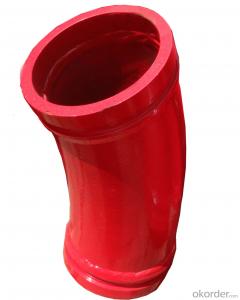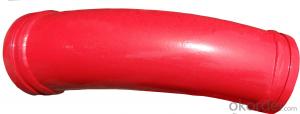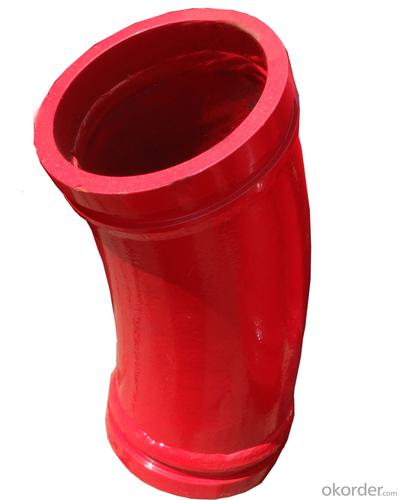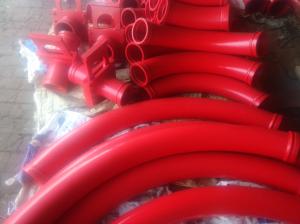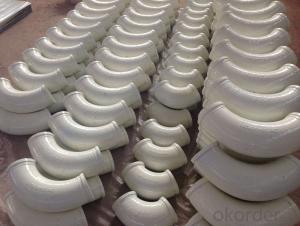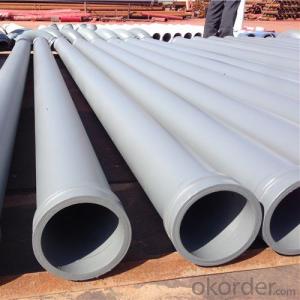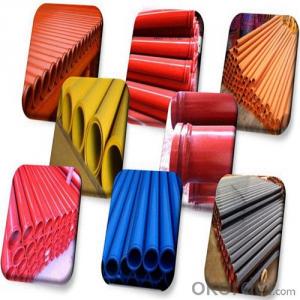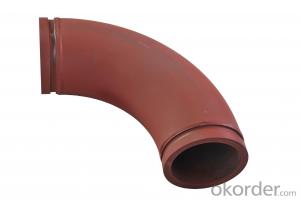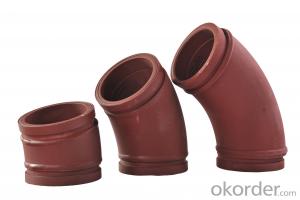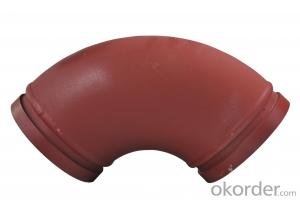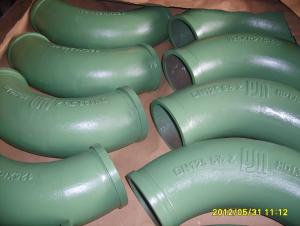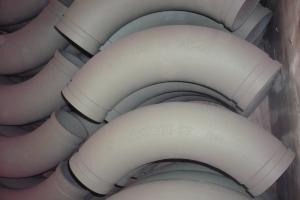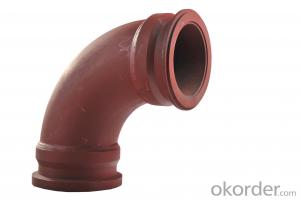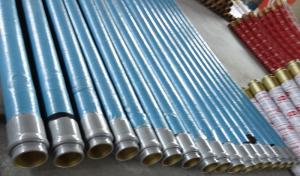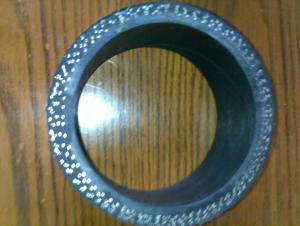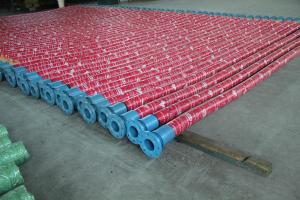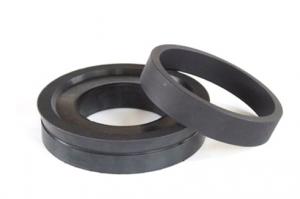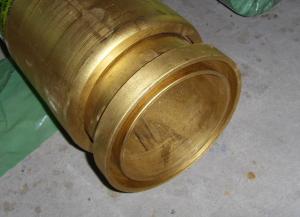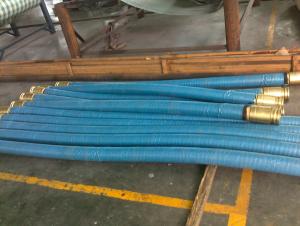Concrete Pump Twin Wall ELBOW R275 90dgr 45dgr 180dgr
- Loading Port:
- Tianjin
- Payment Terms:
- TT or LC
- Min Order Qty:
- 10 pc
- Supply Capability:
- 5000 pc/month
OKorder Service Pledge
OKorder Financial Service
You Might Also Like
Product Name: Concrete Pump Twin Wall ELBOW R275
1. Specification
Dimensions: DN125MM
Radius: 275mm,1000mm
Flange: SK, ZX, F&M
Degree: 30°, 45°, 90°
Material: #20 steel, ST52, Mn 13-4
Thickness: 4.5mm,6mm,7.1mm,7.5mm,10mm,
Working pressure: 180MPa
Notes: total series of concrete pump clamp for different brand concrete pump(PUTZMEISTER, SCHWING, CIFA, SANY, ZOOMLION, IHI, KYOKUTO Etc) available from us.
2. Application of Concrete Pump Twin Wall ELBOW R275
Concrete Pump ELBOW R275, DGR 90 DN100widely used on concrete pump truck, concrete placing boom, trailer concrete pump etc, for concrete delivery pipe connection.
Our concrete pump bends have been successfully exported to many countries from 1998, Our main markets as below: Middle East, Southeast Asia, America, Brazil, Italy, Russia, South Africa etc
Aiming at the largest concrete pump parts manufacturer, and reliable, professional supplier in China, we can supply concrete pump elbows, delivery pipes, casting or forging couplings, end rubber hoses, rubber pistons, tungsten wear plates, delivery cylinders, and other hydraulic parts, one stop service for your concrete pump parts and accessory business.
3. Package and Delivery of Concrete Pump Twin Wall ELBOW R275
Every 60pcs Concrete Pump Bend DN125 put in one seaworthy wooden box, and 20 boxes in one 20feet container.
FAQ:
Q1: Why buy Materials & Equipment from OKorder.com?
A1: All products have its ISO certifications, adheres to the highest standards and a commitment to supply chain safety and customer satisfaction.
Q2: How do we guarantee the quality of our products?
A2: We have established an advanced quality management system which conducts strict quality tests at every step, from raw materials to the final product. At the same time, we provide extensive follow-up service assurances as required.
Q3: How soon can we receive the product after purchase?
A3: Within three days of placing an order, we will begin production. The specific shipping date is dependent upon international and government factors, but is typically 10 to 30 workdays.
Q4: If we can produce some Concrete Pump Twin Wall ELBOW R275 according to customers request?
A4: Yes, we can produce Concrete Pump Twin Wall ELBOW R275 according to the difference country situations and different concrete pump to make it suitable to the market and customers. We have very professional technical team to make the design.
Q5: How to make a quick resolution for after service?
A5:We have overseas branches all-around of world, IF needed, the seller shall dispatch 2 engineers to the buyer's site for supervision of training. The buyer shall make available of necessary facilities &skilled personnel at site for training.
Images:
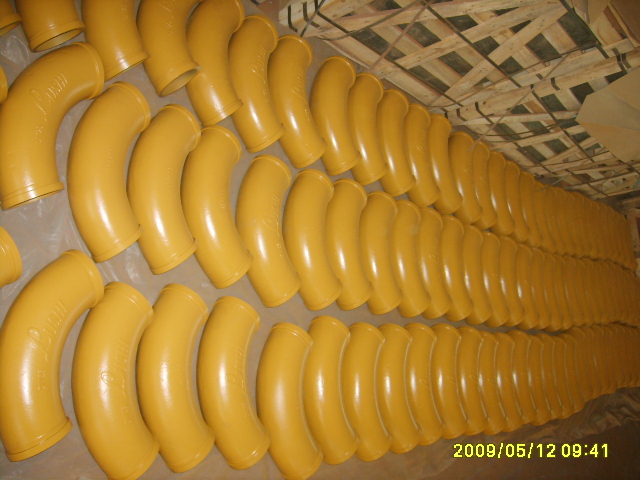
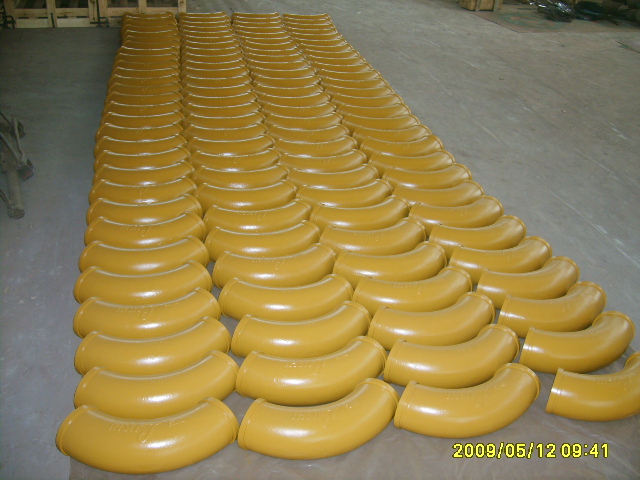
- Q: What are the signs of a damaged concrete pump accumulator?
- Some signs of a damaged concrete pump accumulator may include leaks or fluid seepage, reduced pump performance, irregular pressure readings, increased noise or vibration, and sudden pump shutdowns or malfunctions.
- Q: How does a hopper agitator motor ensure consistent concrete mixing?
- Consistent concrete mixing is guaranteed with the use of a hopper agitator motor, which is responsible for providing the required agitation and movement within the hopper. By rotating and moving the agitator blades, the motor effectively mixes the concrete ingredients. The main purpose of the hopper agitator motor is to avoid the settling or separation of the concrete during the mixing process. Through its rotation, a swirling motion is generated inside the hopper, ensuring even distribution and thorough blending of all the ingredients. This prevents any formation of clumps or irregularities in the final concrete mixture. Moreover, the motor also aids in breaking up any lumps or clusters that may have formed within the hopper. This action further enhances the uniformity of the mixture, ensuring proper blending of components such as cement, aggregates, water, and additives. Furthermore, the continuous movement of the agitator blades helps in maintaining the desired consistency and homogeneity of the concrete mix. It prevents heavier particles from settling at the bottom of the hopper, ensuring consistent mixture throughout the entire mixing process. In conclusion, the hopper agitator motor is of utmost importance in achieving consistent concrete mixing. Its role includes providing necessary agitation, preventing segregation, breaking up lumps, and maintaining uniformity. The motor's rotational motion and well-designed agitator blades contribute to well-mixed and homogeneous concrete, which is crucial for durable and high-quality concrete structures.
- Q: Can I get spare parts for both concrete pumps with and without agitators?
- Yes, you can get spare parts for both types of concrete pumps - those with agitators and those without. Many manufacturers and suppliers of concrete pumps offer a wide range of spare parts to ensure the smooth operation and maintenance of these machines. These spare parts include but are not limited to wear plates, cutting rings, delivery cylinders, pistons, seals, hoses, valves, and filters. It is recommended to contact the manufacturer or authorized dealers of the specific concrete pump brand you are using to inquire about the availability and pricing of spare parts for both types of pumps.
- Q: What are the indications of a malfunctioning concrete pump water pump?
- A malfunctioning concrete pump water pump can be identified through several indicators. 1. Insufficient water flow: A clear sign of a faulty water pump is the lack of water flow. If the pump is not operating correctly, it may fail to supply water to the concrete pump, leading to reduced or no water flow. 2. Decreased water pressure: Another indication of a malfunctioning water pump is reduced water pressure. If the pump is not working properly, it may struggle to generate sufficient pressure for effective water delivery to the concrete pump. This can result in a weaker or inconsistent stream of water. 3. Abnormal noises or vibrations: Strange noises or vibrations emitted by the water pump can suggest a malfunction. Mechanical issues or loose components within the pump can cause these unusual sounds or vibrations. 4. Excessive heat: A malfunctioning water pump can also overheat due to various reasons such as a clogged filter, worn-out bearings, or a faulty motor. Overheating can cause further damage and eventually lead to the pump's complete failure. 5. Leakage: The presence of visible leaks around the water pump indicates a malfunction. Damaged seals or gaskets, loose connections, or cracks in the pump housing can cause leaks. These leaks result in water loss and reduced pump efficiency. 6. Inconsistent or unpredictable water flow: When the water pump is not functioning properly, it can cause irregular or unpredictable water flow. This uneven distribution of water to the concrete pump affects the quality and consistency of the pumped concrete. Regular inspection and maintenance of the water pump are crucial to ensure its proper functioning. If any of these signs are observed, it is advisable to promptly address the issue by seeking professional assistance to diagnose and repair the malfunctioning water pump.
- Q: What are the indications of a damaged concrete pump boom?
- There are multiple signs that can indicate a damaged concrete pump boom. These signs encompass: 1. Physical damage that is visible: One of the most apparent indications of a damaged concrete pump boom is the presence of visible physical damage. This can manifest as cracks, dents, or deformities in the structure of the boom. It is crucial to take any signs of structural damage seriously as they have the potential to compromise the integrity of the boom. 2. Leaks: Another sign of a damaged boom is the occurrence of leaks. If you observe hydraulic fluid or water leaking from the boom, it could be an indication of damage to the hose or fitting. Leaks not only impact the pump's performance but also pose a safety hazard to the operator and those in the vicinity of the equipment. 3. Misalignment: A damaged boom might also display issues with misalignment. If the boom is not straight or appears to be bent at an unusual angle, it could signify damage. Misalignment can negatively affect the accuracy and efficiency of concrete placement, which could result in uneven or improper pouring. 4. Unusual noises: Unusual or excessive noises during operation can be a sign of a damaged boom. Sounds such as rattling, grinding, or squealing may indicate loose or worn-out components like pins, bushings, or bearings. It is important not to ignore these noises as they could worsen if not promptly addressed. 5. Decreased performance: A damaged boom can also lead to reduced performance. If you notice a decrease in pumping capacity or encounter difficulties in controlling the movement of the boom, it could signify damage. Poor performance can stem from various issues, including problems with the hydraulic system, structural damage, or worn-out parts. To conclude, regular inspections and maintenance of concrete pump booms are vital in order to identify any signs of damage. Addressing these issues promptly is essential to ensure the safety of operators, prevent further damage, and uphold the efficiency and performance of the equipment.
- Q: How does a hopper agitator blade ensure smooth concrete flow?
- A hopper agitator blade ensures smooth concrete flow by constantly mixing and agitating the concrete inside the hopper. This prevents the concrete from settling or forming clumps, ensuring a consistent and even flow of the material. The agitation action of the blade also helps to break up any air pockets that may be present in the concrete, resulting in a more uniform and high-quality mixture.
- Q: How often should concrete pump filters be inspected and replaced?
- Concrete pump filters should be inspected regularly, ideally on a weekly basis. The frequency of replacement will depend on various factors such as the type of pump, the quality of concrete being pumped, and the working conditions. Generally, filters should be replaced when they become clogged or when their efficiency is compromised. This may occur anywhere from every few weeks to a few months. It is crucial to maintain clean and functional filters to prevent blockages, enhance pump performance, and ensure the longevity of the equipment.
- Q: Can concrete pump spare parts be customized according to specific requirements?
- Yes, concrete pump spare parts can be customized according to specific requirements. Customization allows for the adaptation of parts to meet specific needs such as size, shape, material, or functionality. This enables better compatibility and enhances the efficiency and performance of concrete pumps.
- Q: What are the advantages of using ceramic components in concrete pump spare parts?
- There are several advantages of using ceramic components in concrete pump spare parts. Firstly, ceramic materials are known for their exceptional durability and wear resistance. Concrete pumps operate under high pressure and require components that can withstand the intense forces and abrasion. Ceramic parts have superior hardness and strength, making them highly resistant to wear and extending the lifespan of the spare parts. Secondly, ceramic components have excellent corrosion resistance. Concrete contains various chemicals and substances that can be corrosive to metals. By using ceramic parts, the risk of corrosion is significantly reduced, ensuring the longevity and reliability of the concrete pump spare parts. Additionally, ceramic materials have low friction coefficients. This means that when ceramic components are used in concrete pumps, there is less friction between the moving parts, resulting in reduced energy consumption and increased efficiency. This can lead to cost savings and improved overall performance of the concrete pump. Furthermore, ceramic parts have a high thermal resistance. Concrete pumps generate heat during operation, and this can cause damage or deformation to certain components. However, ceramic materials can withstand high temperatures without losing their structural integrity, ensuring the reliability and safety of the concrete pump. Lastly, ceramic components have excellent dimensional stability. They are less prone to expansion or contraction due to temperature changes, ensuring that the spare parts maintain their shape and fit accurately within the concrete pump. This precision fitting helps to minimize leakage and maintain the efficiency of the pump. In summary, the advantages of using ceramic components in concrete pump spare parts include exceptional durability, corrosion resistance, low friction, high thermal resistance, and dimensional stability. These benefits contribute to increased lifespan, improved performance, reduced maintenance costs, and enhanced overall efficiency of the concrete pump.
- Q: Can concrete pump spare parts be recycled or disposed of responsibly?
- Yes, concrete pump spare parts can be recycled or disposed of responsibly. Many components of concrete pump spare parts, such as steel and rubber, can be recycled. These materials can be separated and processed for reuse in other industries. Additionally, responsible disposal methods, such as proper waste management systems, can be employed to ensure that any non-recyclable parts are disposed of in an environmentally friendly manner. Overall, efforts can be made to minimize the environmental impact associated with concrete pump spare parts by adopting recycling and responsible disposal practices.
Send your message to us
Concrete Pump Twin Wall ELBOW R275 90dgr 45dgr 180dgr
- Loading Port:
- Tianjin
- Payment Terms:
- TT or LC
- Min Order Qty:
- 10 pc
- Supply Capability:
- 5000 pc/month
OKorder Service Pledge
OKorder Financial Service
Similar products
Hot products
Hot Searches
Related keywords
